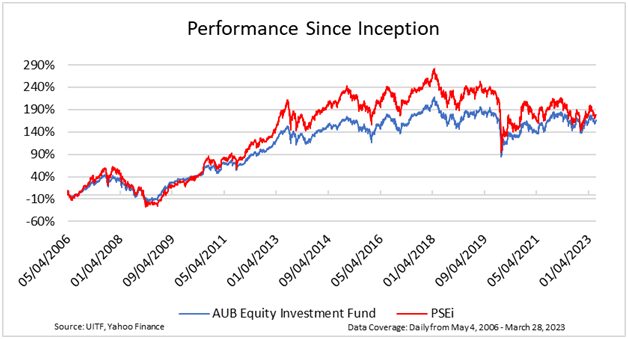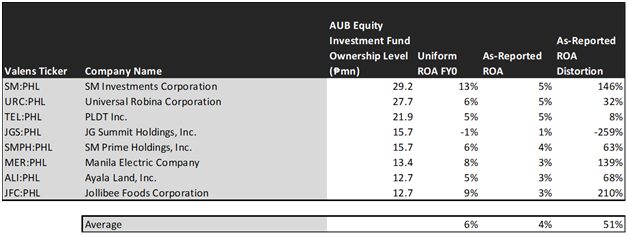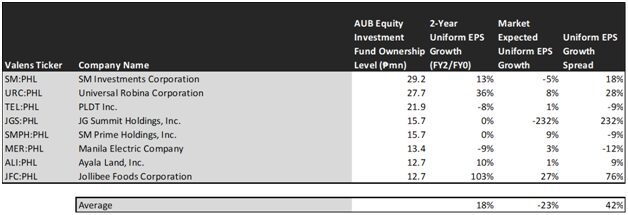This bank developed a Unified Card QR Link that made cashless payments at the point of purchase easier… also,

The Rebisco-led Asia United Bank (AUB) has been improving its Information Technology platforms to make merchants’ and consumers’ shift to cashless payments easier.
For example, AUB enabled its PayMate users to accept Mastercard and Visa payments using just one quick response (QR) code, a big boost to micro and small businesses. It also collaborated with Atome and MatchMove to allow users to buy now and pay up to 45 days later with a P200,000 credit limit. Lastly, AUB enabled its e-wallet’s cross-border operations through Alipay+.
Here we look at one of the institution’s unit investment trust funds (UITF). On top of examining the fund’s portfolio, we will provide you with the current Uniform Accounting Performance and Valuation Tearsheet for one of the fund’s largest holdings.
Philippine Markets Newsletter:
Friday Uniform Portfolio Analytics
Powered by Valens Research
Asia United Bank (AUB), a Rebisco-led company, has been making significant strides in introducing new products and services to enhance its customers’ banking experience. The bank’s focus on cost-efficient solutions in response to customer demands, with heavy reliance on IT, has made its competitive edge.
AUB’s latest initiatives include the launch of the Unified Card QR Link, which allows PayMate users to accept Mastercard and Visa payments using a single quick response (QR) code. This innovative solution is expected to benefit micro and small businesses, as it enhances their ability to accept electronic payments.
Furthermore, AUB has partnered with buy now, pay later (BNPL) platform provider Atome and Singapore-based fintech firm MatchMove to introduce the Atome Card in the Philippines. This collaboration will help drive financial inclusion for the unbanked and underbanked, with no annual fees or sign-up fees for the card. The virtual or physical card can be used at any in-store or online retailer that accepts Mastercard.
In addition, AUB has partnered with Alipay+ to enable HelloMoney for cross-border payments when customers travel abroad. HelloMoney will first be available and accepted in South Korea and Japan, allowing HelloMoney users to pay at local merchants accepting Alipay+ for shopping, dining, convenience stores, transportation, and other travel-related activities.
While the bank’s digital banking initiatives move forward, let’s take a look at its investment activities, focusing on one of its UITFs, the Equity Investment Fund.
The AUB Equity Investment Fund was launched on May 4, 2006, with the aim to achieve a rate of return equivalent to the rolling 90-day yield of the Philippine Stock Exchange Index (PSEi), net of fees. The Fund is an equity fund invested in blue chips and major second-line issues included in the PSEi. To minimize its investment risk, the Fund has diversified investment only in fundamentally sound companies.
This type of investment is recommended for investors with an aggressive risk appetite and an investment horizon of at least three years with a willingness to accept higher risk, higher volatility of returns and even possible loss of principal.

- At its inception in May 2006, AUB Equity Investment Fund’s beginning net asset value per unit (NAVPU) was PHP 100. The fund’s value shrunk by 20% in October 2008 during the global financial crisis. Its benchmark slightly underperformed, shrinking by 28%.
- In March 2010, the fund began to bounce back to around PHP 137 and continued to climb reaching its peak at PHP 201 in July 2012. This value doubled its initial NAVPU price fueled by the expansion of business process outsourcing (BPO) and tourism industries. From its lowest in October 2008, the fund grew by 152% while PSEi grew by 213% in the same period.
- In around six years of the stable movement, the fund’s NAVPU dropped to PHP 187, a 41% shrinkage from its peak at PHP 317 in January 2018, following the announcement of the lockdown due to COVID-19. PSEi slightly underperformed at 48% shrinkage during the same period.
- The fund was able to recover at PHP 285 at the end of the year 2021 from its bottom in March 2020, and the fund’s 52% growth slightly underperformed its benchmark growth of 55%. This is due to the availability of COVID-19 vaccines and fewer restrictions on economic activities.
- In response to the U.S. Fed’s aggressive raising of interest rates to fight inflation, the fund dropped by 16% in the third quarter of 2022, from its climb at the beginning of the year, and it slightly outperformed its benchmark’s drop of 21%.
- By the first quarter of 2023, the fund and PSEi recovered by 11% and 13%, respectively. Since its inception, the fund underperformed its benchmark, recording a 166% gain versus PSEi’s 179% growth.
With the fund underperforming its benchmark, let’s take a look at the quality of the companies in its holdings. As-reported metrics would have investors believe that the fund’s portfolio consists of companies that don’t appear to break even. Uniform Accounting reveals the truth behind the companies this fund invests in.
The table below shows the top eight core non-financial holdings of AUD Equity Investment Fund along with its Uniform return on assets (ROA), as-reported ROA, and ROA distortion—the difference between Uniform and as-reported ROA.

Most of the companies in AUB Equity Investment Fund show as-reported ROAs below cost-of-capital levels, suggesting that they are not generating economic profit. Moreover, the fund is generating an average as-reported ROA of 4%, below the global corporate average returns of 6%.
However, on a Uniform Accounting basis, this UITF’s holdings have actually delivered a Uniform ROA of 6%, a profitability in line with global corporate average.
The Uniform Accounting framework addresses financial statement inconsistencies attributable to the flaws present in the Philippine Financial Reporting Standards (PFRS). This enables investors to determine the true underlying performance of companies and avoid distorted financial analysis and valuation.
As such, it should not be surprising that when analyzing the non-financial holdings of AUB Equity Investment Fund, the figures that easily stand out are the large discrepancies between Uniform ROA and as-reported ROA for these companies.
While at a glance, the difference between as-reported ROA and Uniform ROA may not seem that great, the distortion in percentage ranges from -259% to 210%, with Jollibee Foods Corporation (JFC:PHL), SM Investments Corporation (SM:PHL), and Manila Electric Company (MER:PHL) having the highest positive distortions.
Among these holdings, PLDT Inc. (TEL:PHL) and JG Summit Holdings, Inc. (JGS:PHL) were revealed to have a Uniform ROA below or in line with as-reported ROA, presenting a potential cause for concern. Companies such as this need to be closely monitored for drastic changes that could negatively affect the fund itself, especially when the support behind the stocks’ performance begins to wane.
As-reported metrics understate the profitability of Jollibee Foods Corporation, suggesting a below-average firm with an as-reported ROA of 3%. In reality, this firm more closely resembles one that is highly profitable, with a Uniform ROA of 9% above the average cost of capital. In addition, the company has consistently generated returns of at least 5% over the past decade, excluding 2020.
Similarly, as-reported metrics understate the profitability of SM Investments Corporation with an as-reported ROA of 5%. In fact, its Uniform ROA is at 13%, when its lowest was 8% over the past decade.
Likewise, as-reported metrics understate the profitability of Manila Electric Company, suggesting a below-average firm with an as-reported ROA of only 3% when this company actually has a 8% Uniform ROA.
By focusing on as-reported metrics alone, these companies look like anything but profitable businesses.
That said, looking at profitability alone is insufficient to deliver superior investment returns. Investors should also identify if the market is significantly undervaluing a company’s earnings growth potential.

This table shows the earnings growth expectations for the major non-financial holdings of the fund. It features three key data points:
- The two-year Uniform earnings per share (EPS) growth represents the Uniform earnings growth the company is likely to have for the next two years. The earnings number used is the value when we convert consensus sell-side analyst estimates according to the Uniform Accounting framework.
- The market expected Uniform EPS growth represents what the market thinks Uniform earnings growth is going to be for the next two years. Here, we show how much the company needs to grow Uniform earnings in the next two years to justify the current stock price of the company. This is the market’s embedded expectations for Uniform earnings growth.
- The Uniform EPS growth spread is the difference between the two-year Uniform EPS growth and market expected Uniform EPS growth.
On average, Philippine companies are expected to have 5%-6% annual Uniform earnings growth over the next two years. Meanwhile, AUB Equity Investment Fund’s major holdings are forecasted to significantly outperform with an 18% projected Uniform earnings growth in the next two years, while the market is forecasting an average with a projected 23% Uniform earnings shrinkage.
Most of the companies in AUB Equity Investment Fund have positive Uniform earnings growth. Among these companies, Jollibee Foods Corporation, Universal Robina Corporation (URC:PHL), and SM Investments Corporation have the highest positive Uniform earnings growth spread.
The market is pricing Jollibee Foods Corporation’s Uniform earnings to grow by 27% in the next two years, while sell-side analysts are projecting a 103% growth for the company’s earnings.
Moreover, the market is pricing Universal Robina Corporation’s Uniform earnings to grow by 8% in the next two years, while sell-side analysts are projecting the company’s earnings to grow by 36%.
Finally, the market is pricing SM Investments Corporation’s Uniform earnings to shrink by 5% in the next two years, while sell-side analysts are projecting the company’s earnings to grow by 13%.
Overall, as-reported numbers significantly understate the expected earnings of these companies, as shown by the Uniform-adjusted sell-side estimates.
Uniform Accounting metrics show that these mature but high-growth and high-return companies have intact business models that should drive economic profitability moving forward.
SUMMARY and PLDT Inc. Tearsheet
Today, we’re highlighting one of the largest individual stock holdings in the AUB Equity Investment Fund, PLDT Inc. (TEL:PHL).
As the Uniform Accounting tearsheet for PLDT Inc. highlights, the company trades at a Uniform P/E of 19.6x, which is around the global corporate average of 18.4x but above its historical average of 17.6x.
Moderate P/Es require moderate EPS growth to sustain them. In the case of PLDT Inc., the company showed a 14% Uniform EPS shrinkage last year.
Sell-side analysts provide stock and valuation recommendations that poorly track reality. However, sell-side analysts have a strong grasp of near-term financial forecasts like revenue and earnings.
We take sell-side forecasts for Philippine Financial Reporting Standards (PFRS) earnings as a starting point for our Uniform earnings forecasts. When we do this, PLDT Inc.’s sell-side analyst-driven forecast shows that Uniform earnings are expected to grow by 18% in 2022 and shrink by 27% in 2023.
Based on the current stock market valuations, we can back into the required earnings growth rate that would justify PLDT Inc.’s PHP 1,310 stock price. These are often referred to as market-embedded expectations.
Furthermore, the company has an earning power below the long-run corporate averages. Moreover, its cash flows and cash on hand fall short of obligations, and it also has an intrinsic credit risk of 150bps. Together, these indicate a high dividend risk and moderate credit risk.
Lastly, PLDT Inc.’s Uniform earnings growth is above peer averages and in line with peer average valuations.
About the Philippine Markets Daily
“Friday Uniform Portfolio Analytics”
Investors who don’t engage in the buying or selling of securities for a living often rely on professionals to manage their own investments within the scope of their investment policies.
With so many funds and managers out there, it can get confusing and difficult to decide which one best suits your needs as an investor.
Every Friday at the end of the month, we focus on one fund in the Philippines and take a deeper look into their current holdings. Using Uniform Accounting, we identify the high-quality stocks in their portfolio which may not be obvious using the as-reported numbers.
We also identify which holdings may be problematic for the fund’s returns that they would need to reconsider from a UAFRS perspective.
To wrap up the fund analysis, we highlight one of their largest holdings and focus on key metrics to watch out for, accessible in our tearsheets.
Hope you’ve found this week’s focus on AUB Equity Investment Fund interesting and insightful.
Stay tuned for next week’s Friday Uniform Portfolio Analytics!
Regards,
Angelica Lim
Research Director
Philippine Markets Daily
Powered by Valens Research
www.valens-research.com




